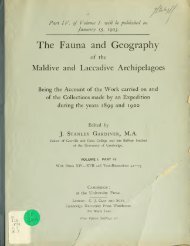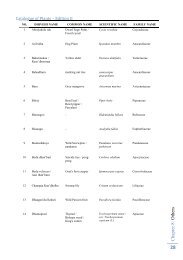Download - WordPress – www.wordpress.com
Download - WordPress – www.wordpress.com
Download - WordPress – www.wordpress.com
You also want an ePaper? Increase the reach of your titles
YUMPU automatically turns print PDFs into web optimized ePapers that Google loves.
MARINEMOLLUSCA.By Edgar A. Smith, I.S.O.(With PlatesXXXV. and XXXVI.)As the first collection of Marine Mollusca of any importance that has hitherto beenobtained at the Maldive Islands, that about to be described is of considerable interest. Itconsists of about 380 different species and probably <strong>com</strong>jorises a large proportion of theforms which occur in these islands. That many have escaped notice and will eventually becollected by others is quite certain, but it seems probable that most of the larger speciesare represented in this collection and that it is only among the smaller and obscurer formsthat many additional species will hereafter be discovered.\^ There are, however, certain <strong>com</strong>mon and widely distributed species which one wouldhave expected to have been found, notably belonging to the genera Conus, Terebra, Sistrum,Purpura, Nassa, Oliva, Solarium, Truchus and Circe. It is also worthy of remark thatcertain genera which have representatives in the surrounding seas do not aj^pear to havebeen met with. Of these I may mention Fasciolaria, Rissoa, Patella, Eulinia, Hydatina,Aplysia,Umbraculiim and Mytilus.As might be expected the fauna is similar to that of other islands in the IndianOcean, many of the species occurring in Ceylon, Mauritius, Madagascar, the Amirantes,Seychelles, and a great many ranging as far north as the Red Sea and Persian GulfRather more than a seventh of the forms have been recorded from the Andamans, andprobably many others occur at these and the neighbouring Nicobar group. It is well knownthat great numbers of marine molluscs have a very wide range, and therefore it is notsurprising that many, in fact about three-fourths, of the Maldive shells are kno\vn to occurin the seas surrounding the Philippine Islands and the Malay Archipelago, and still furthernorth about one-fourth of the species have been recorded from the islands of Japan. Inthe Pacific, from the East coast of Australia to the Loyalty Islands and Polynesia, ratherover three-sevenths of the Maldive species have been recorded, many of them ranging allover both the Indian Ocean and the Malay region also. About one-third of the speciesare known from Ceylon, but doubtless many more occur there, although they may not havebeen recorded. About 177 species have been found at the Mauritius, the fauna of whichhas been more extensively worked than that of the Seychelles. With regard to the generaldistribution of the species about to be recorded, it is curious to observe that a largerprojjortion of them have previously been noted from the China Sea eastward and in thePacific, than in the Indian Ocean, including the Red Sea and Persian GulfThe following table shows at a glance the distribution of the species as far as thewriter has been able to ascertain without a very exhaustive search. The column underMalaysia includes species which occur in the China Sea, the Philippine Islands, MalayArchipelago, N. Australia, New Guinea, and as far east as the Solomon Islands. UnderPol\Tiesia are indicated the species which are met with either in E. Australia or at theLoyalty Islands, or at the various groups of islands of Polynesia.G. II. 76






